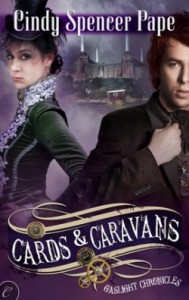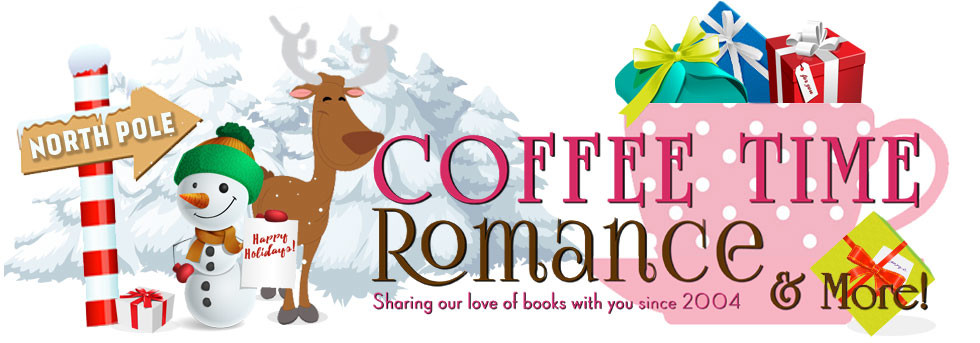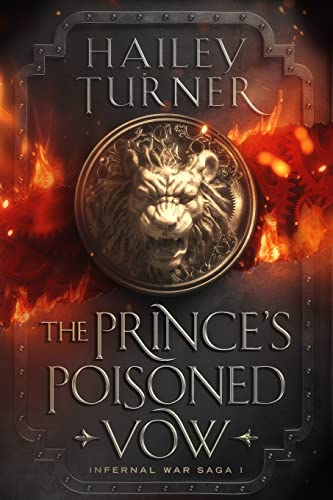 Cindy Spencer Pape, author of the Gaslight Chronicles (Carina Press), blogged at Steamed! in late 2013 about the possibility of her series coming to an end:
Cindy Spencer Pape, author of the Gaslight Chronicles (Carina Press), blogged at Steamed! in late 2013 about the possibility of her series coming to an end:
“One of my first projects for 2014 is to finish and turn in Ether & Elephants (working title), the last book so far contracted in the Gaslight Chronicles. While I won’t swear that this is the end, the cold, hard fact is that steampunk isn’t selling anywhere near as well as publishers originally expected. Fewer and fewer publishers are contracting the genre at all, and it’s becoming increasingly clear that steampunk is far more lifestyle than literary.”
In related news, Zoe Archer and Nico Rosso’s Ether Chronicles has ended with book five, Skies of Gold. This occurred despite potential for more stories in their shared world, so Ms. Pape might not be the only author re-evaluating the steampunk romance path.
Ms. Pape also left a comment about the state of steampunk romance, stating that “The truth is that in the fiction world, it never really took off, barring just a few major authors.”
Her post and comment, as well as the discussion that followed, raised a few points worth noting.
First, I must commend her as well as other steampunk romance authors for taking a risk on a genre in its very early stage. I’ve been blogging about steampunk romance since 2008. At the time, I could practically count the existing steampunk romance titles on one hand. So it was exciting to see authors take a chance on it.
Despite Ms. Pape’s concerns, I’m not convinced steampunk romance has generated enough books yet to measure either success or failure. Like any genre before it, steampunk romance needs time to build. Seems to me it was only yesterday when readers—particularly romance ones—even learned what it is.
Perhaps it’s a slow-cooker genre rather than a stir-fry.
The slow-cooking aspect can be undoubtedly frustrating for some authors. It can be a challenge to decide how many steampunk romance stories one should write, especially if the short-term gains are shrouded in mystery or turn out less than expected (i.e., low sales and royalties).
Authors of digital-first steampunk romances have the freedom to explore all kinds of steampunk romance stories of all kinds of lengths. That’s pretty awesome for readers. At the same time, the books lack a distinct advantage: mainstream print distribution. Not so awesome for readers who can’t find the nigh-invisible stories because too little marketing is being done. Authors are likely left wondering at times if their efforts are worth it.
Yet genres like steampunk romance, because they are so incredibly niche, can’t carry the authors along—it needs nurturing. Sometimes the nurturing is Time itself. Other types of nurturing include word-of-mouth, grassroots campaigns organized by fans and authors, author-driven marketing, and innovative storytelling. Publishers provide distribution of one kind or another, but unless one is a brand name, mainstream print author, then the likelihood of getting a major marketing push is minimal. In the case of steampunk romance, its future is in the hands of readers and authors.
There’s also a difference between steampunk romance not being viable for an individual author vs. the genre being viable as a whole. Many authors in many genres (unfortunately) fail to gain living wages from their royalties, let alone fame and fortune. But it doesn’t always signal the end of a genre. Granted, they cycle up and down. With steampunk romance, we’re either witnessing growing pains or a down cycle.
We also must consider that an individual author’s (or group of authors’) perceived failure may in fact be one of the crucial factors in the genre’s overall development. As they say, you can’t make an omelette without breaking eggs.
I really hope authors don’t throw in the towel just yet. (And if you have to throw in the towel, toss it to another author who’s ready to dry off! Er, I mean willing to carry the torch.) Lucky for all of us, ebooks have a much longer shelf life than print ones.
On that note, Ms. Pape’s article inspired a substantial discussion in the comment section. Numerous visitors indicated an active interest in steampunk/steampunk romance as well as ideas for attracting new readers.
Other ideas for keeping steampunk romance viable include
* branching out into non-Victorian settings, e.g. space (see also my post here at Coffee Time Romance about multicultural steampunk romance),
* self-publishing titles (especially if publishers aren’t interested in acquiring steampunk romance)
* tapping into non-romance steampunk stories for inspiration
* take more advantage of progressive steampunk romance heroines
* generate more steampunk romance anthologies
Those are all great ideas. What would you suggest to help steampunk romance grow?
About the author
Heather Massey is a lifelong fan of science fiction romance. She searches for sci-fi romance adventures aboard her blog, The Galaxy Express. She’s also an author in the subgenre. To learn more about her published work, visit heathermassey.com.











I have had great fun exploring this genre and am really grateful for the authors that have put so much time and effort and research into writing these wonderful stories and then sharing them with us. Thank you for sharing with us today.
I still love steampunk and do want to continue with the genre. Eventually anyway! My 2014 is pretty much scheduled but maybe next year. I would eventually like to write in my Starlander Frontier world again.
I’m one of the Indie authors delighted to be writing steampunk romance. My newest release, “Prudence and the Professor” is set in the American West during the war-between-the states. I wrote a steampunk short story several years ago, and needed to finish several projects before returning to a sub-genre I love writing.
It’s unfortunate that some publishers have decided that the market isn’t lucrative enough for them to continue publishing steampunk romance, but that doesn’t have to mean the end of a sub-genre. They’ve said that for years about Westerns, but I sell my Indie published books every day.
One of the things I love about steampunk romance is the variety of settings, stories and characters. I find a lot of historical romance, especially from the Big 5 publishers, is strikingly similar (just note the number of Regency era and Scottish historical romance reviewed every month) and seems closed to new settings, eras, etc.
This is a trend I’ve noticed after writing romance for nearly twenty years. At the point when you hear a certain sub-genre is “dead” can be the time when the reader begins to demand more of those stories. It used to be that the reader had to accept the judgement of the publishing companies. That time has passed.
Readers create demand, not publishers – they can only respond, or fail to respond, but a reader will find the book they are searching for.
I sincerely hope one of them is mine.
Great question, Heather. I am coming somewhat late to the discussion. I will continue to write sexy steampunk romance because I love the genre and have a lot of fun with it. I have 2 stories coming out in 2014 and I only sold the second story this month (March 2014), so some publishers are still acquiring stories.
Overall I am hoping that the genre will continue to grow. If it doesn’t I will just have to make my money with my sci-fi stories…oh wait, that is another nice genre;).